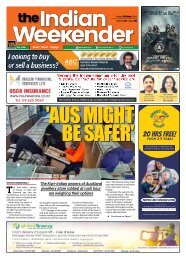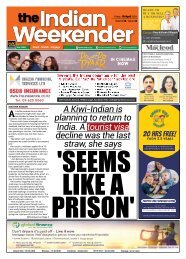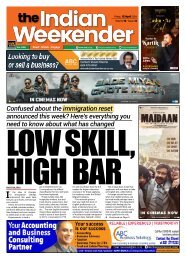The Indian Weekender, 12 March 2021
Weekly Kiwi-Indian publication printed and distributed free every Friday in Auckland, New Zealand
Weekly Kiwi-Indian publication printed and distributed free every Friday in Auckland, New Zealand
You also want an ePaper? Increase the reach of your titles
YUMPU automatically turns print PDFs into web optimized ePapers that Google loves.
10 NEW ZEALAND<br />
Friday, <strong>March</strong> <strong>12</strong>, <strong>2021</strong><br />
<strong>The</strong> <strong>Indian</strong> <strong>Weekender</strong><br />
National says opening of one-way<br />
travel bubble with Australia can<br />
reunite migrant workers’ families<br />
SANDEEP SINGH<br />
National Party is saying that opening of<br />
one-way travel bubble with Australia<br />
can help two critically affected sectors<br />
in New Zealand economy – Tourism & getting<br />
highly skilled migrant workers into the country.<br />
<strong>The</strong> party’s spokesperson for Covid-19<br />
response Chris Bishop said, “it’s clear the trans-<br />
Tasman bubble negotiations are going nowhere<br />
under Labour, and it’s time for New Zealand to<br />
take action to save our tourism sector.<br />
“Australia has moved and now we<br />
need to move as well. We decide when<br />
we open our border – the decision is not<br />
subcontracted to Australia.<br />
“We could start accepting travellers from<br />
Australia, provided they have a negative predeparture<br />
test, from tomorrow – and that’s<br />
exactly what we should do,” Bishop said.<br />
This was after Covid-19 Response<br />
Minister Chris Hipkins told the parliament on<br />
Wednesday, <strong>March</strong> 10, that after <strong>12</strong> rounds<br />
of talks over many months on a common<br />
framework, both parties [NZ & Australia] have<br />
effectively left the negotiating table.<br />
<strong>The</strong> National is asking that the government<br />
should consider opening one-way travel<br />
bubble to get more tourists and travellers into<br />
the country and help the tourism sector that is<br />
desperately looking for more visitors into the<br />
country or some substantial support from the<br />
government.<br />
<strong>The</strong> Party’s Immigration Spokesperson Erica<br />
Stanford is saying that such unilateral opening<br />
National Says- Left- Chris Bishop National Party’s spokesperson for Covid-19 response, (Right)- National<br />
Party's Immigration Spokesperson Erica Stanford<br />
of the travel bubble can potentially solve<br />
another major issue of attracting and<br />
retaining the highly skilled migrant<br />
workforce in the country.<br />
“New Zealand risks eroding our<br />
critical migrant workforce – our<br />
medical specialists, mathematics<br />
teachers, engineers and tech<br />
experts – because those workers<br />
have no hope on the horizon of<br />
reunification with their families.<br />
“Despite countless heart-breaking stories of<br />
workers who have been separated from their<br />
partners and children, in many cases for more<br />
than a year, Minister Faafoi has ignored this<br />
problem for eight months.”<br />
“A travel bubble with Australia would<br />
"New<br />
Zealand risks<br />
eroding our critical<br />
migrant workforce –<br />
our medical specialists,<br />
mathematics teachers, engineers<br />
and tech experts – because those<br />
workers have no hope on the<br />
horizon of reunification<br />
with their families"<br />
see MIQ spots freed up so<br />
these critical workers can<br />
be reunited with their<br />
families,” Stanford said.<br />
Notably, tens of<br />
thousands of temporary<br />
migrant workers who<br />
were ordinarily resident<br />
in New Zealand remains<br />
locked out of NZ borders<br />
ever since bordered were closed<br />
almost a year ago on <strong>March</strong> 19, 2020.<br />
<strong>The</strong> temporary migrants, including those on<br />
student visas, post-study work visa, essential<br />
skill visa, open work visa, and partners<br />
and families have not only invested tens of<br />
thousands of dollars for a dream of Kiwi-life<br />
in NZ and have spent several years living and<br />
working in the country towards that now elusive<br />
dream. <strong>The</strong> government had only allowed back<br />
a minuscule category of essential skilled work<br />
visa holders in a staggered manner that will<br />
only allow potentially around 850 temporary<br />
migrants back into the country, while others<br />
still remain locked out with no respite in sight.<br />
<strong>The</strong> government had always shrugged off<br />
the urgent need of allowing those temporary<br />
migrants back into the country, hiding behind<br />
the pretext of “limited capacity of MIQ<br />
facilities”, which continues to serve the citizens<br />
and residents only largely.<br />
<strong>The</strong> government had also explicitly denied<br />
any intention of expanding MIQ facilities that<br />
can potentially be targeted to serve temporary<br />
migrants – both stuck offshore and onshore.<br />
Temporary migrant workers<br />
trapped inside NZ’s closed<br />
borders<br />
It is also important to note that the current<br />
closed border regime had also entrapped more<br />
than 200,000 temporary migrant workers<br />
who are currently onshore and cannot travel<br />
overseas without risking losing the right to reenter<br />
the country.<br />
Those temporary migrant workers are<br />
currently living as an underclass in New<br />
Zealand, seeing citizens and residents travelling<br />
overseas at the time of family emergencies such<br />
as grieving with death or terminal sickness in<br />
overseas family, while they are continued to be<br />
denied of any such compassion.<br />
Record number of property<br />
sales in month of February<br />
SANDEEP SINGH<br />
<strong>The</strong> number of residential properties<br />
sold in February across New Zealand<br />
increased by 14.6% when compared to<br />
the same time last year (from 6,951 to 7,964)<br />
– the highest for the month of February in 14<br />
years, according to the latest data from the Real<br />
Estate Institute of New Zealand (REINZ).<br />
For New Zealand excluding Auckland, the<br />
number of properties sold increased by 6.1%<br />
when compared to the same time last year<br />
(from 4,890 to 5,189).<br />
“Even with LVRs coming back<br />
into effect in <strong>March</strong>, we would<br />
expect to see sales volumes<br />
continue at a solid pace over<br />
the next couple of months; but<br />
this will in part rely on a steady<br />
stream of new listings coming<br />
onto the market,<br />
In Auckland, the number of properties sold<br />
in February increased by 34.6% year-on-year<br />
(from 2,061 to 2,775) – the highest for the<br />
month of February in 14 years.<br />
Bindi Norwell, Chief Executive at REINZ<br />
says: “<strong>The</strong> unrelenting pace of property sales<br />
continued in February, with a 14.6% uplift on<br />
sales volumes compared to the same time last<br />
year; the highest number of properties sold for<br />
the month of February in 14 years.<br />
“It’s highly likely that some of this uplift<br />
can be attributed to both investors and owneroccupiers<br />
looking to purchase ahead of the LVR<br />
restrictions coming back into effect in <strong>March</strong><br />
and the slight uplift in listings we’ve seen over<br />
the last couple of months,” she continues.<br />
“<strong>The</strong> Auckland market has seen one of the<br />
largest percentage increases in sales volumes<br />
across the country when compared to the<br />
same time last year, with a 34.6% uplift in the<br />
number of residential properties sold. This is<br />
remarkable when you consider Auckland had<br />
four days of Level 3 lockdown in February and<br />
shows how adaptable both agents and members<br />
of the public are at moving to technology<br />
solutions to buy and sell houses when physical<br />
viewings are extremely limited.<br />
“Even with LVRs coming back into effect in<br />
<strong>March</strong>, we would expect to see sales volumes<br />
continue at a solid pace over the next couple<br />
of months; but this will in part rely on a steady<br />
stream of new listings coming onto the market,”<br />
continues Norwell.<br />
Median prices for residential property<br />
across New Zealand increased by 22.8%<br />
from $635,000 in February 2020 to $780,000<br />
in February <strong>2021</strong> a new record high for the<br />
country.<br />
Median house prices for New Zealand<br />
excluding Auckland increased by 19.1% from<br />
$550,000 in February last year to $655,000.<br />
Auckland’s median house price increased by<br />
24.3% from $885,000 at the same time last year<br />
to $1,100,000 – a new record for Auckland.<br />
Additionally, Auckland City, Franklin District,<br />
Manukau City, North Shore City, Papakura<br />
District and Waitakere City all reached new<br />
record median highs.<br />
Nearly a third of NZ homes sold by auction<br />
in February – highest level of auctions ever<br />
February saw nearly a third of all properties<br />
sold by auction (29.2%), with 2,322 properties<br />
selling under the hammer – up from 16.4% at<br />
the same time last year, when 1,139 properties<br />
were sold via auction. This was the highest<br />
percentage of auctions we’ve ever seen in New<br />
Zealand.<br />
Auckland was the third region nationwide<br />
with 47.0% (1,303 properties) sold under the<br />
hammer up from 31.3% in February 2020 (645<br />
properties).<br />
This was the highest percentage of auctions<br />
in a February month since records on sales<br />
methods began.


















